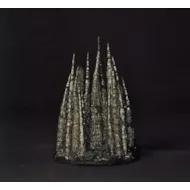An unsual Tin Specimen from Australia contained in its original box
An unsual Tin Specimen from Australia contained in its original travelling box with old label
size : 27 cm h x 16.5 cm dia.
10½ ins h x 6½ ins dia.
size : 27 cm h x 16.5 cm dia.
10½ ins h x 6½ ins dia.
Tin is quite a rare natural element occurring chiefly in the mineral Cassiterite. The earliest workings for tin must have been among the detrital material on hillsides and the alluvial gravels in the lower reaches of rivers. From these ore-rich pebbles and rock fragments tin would have been recovered.
The first use of tin probably coincided with the development of crude smelting methods for making tools and weapons out of bronze, which is an alloy of copper and tin, in the era known as the Bronze Age.
There were very few sizable deposits of tin in the ancient world and the value of the metal for making bronze led to the establishment of trading routes between southwest England and various Greek and later Roman centres by about 1500 BC.
The Greek historian, Herodotus in 440 BC gave the first account of the tin trade in the west staing: 'Nor have I any knowledge of tin islands (Cassiterides) whence our tin is brought.'
The first use of tin probably coincided with the development of crude smelting methods for making tools and weapons out of bronze, which is an alloy of copper and tin, in the era known as the Bronze Age.
There were very few sizable deposits of tin in the ancient world and the value of the metal for making bronze led to the establishment of trading routes between southwest England and various Greek and later Roman centres by about 1500 BC.
The Greek historian, Herodotus in 440 BC gave the first account of the tin trade in the west staing: 'Nor have I any knowledge of tin islands (Cassiterides) whence our tin is brought.'
An unsual Tin Specimen from Australia contained in its original box

SOLD
